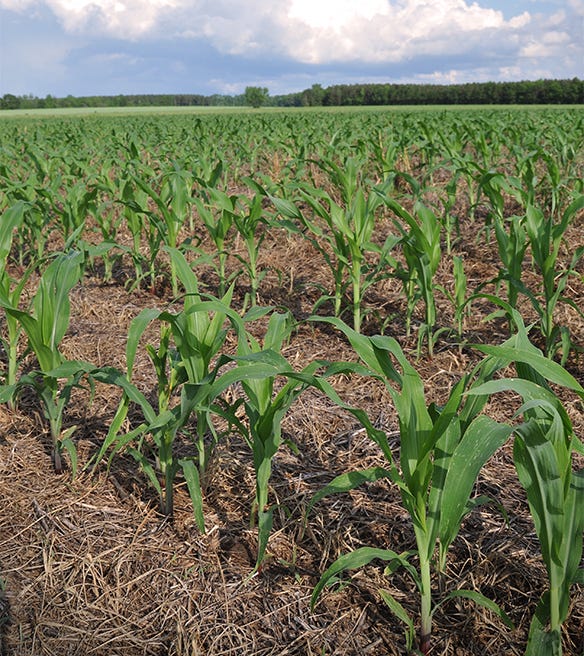
It seems like there could be plenty to worry about when switching to no-till.
Will you be able afford the new equipment you might need? Will you be able to plant on time? Will you be able to seed through the residue? Will you get a good stand? Will weeds get away from you? Will your yields be as good as with tillage?
But going 100% no-till went super smooth for Jason Kontz. He didn’t have any no-till jitters — perhaps thanks to a few things that he did really well.
First, he was motivated. “I wasn’t happy with what was happening with my soil,” says the Colman, S.D. farmer. He and his wife, Morgan, raise corn and soybeans and finish cattle.
They were seeing wind erosion on their tilled fields. Also, in the spring, many fields would be too wet. Over the summer, rain would runoff instead of going into the soil, creating gullies on the slopes as the water flowed to the potholes and lowlands.
“We couldn’t keep going on this way,” he says.
Second, Kontz had some experience no-tilling. He and his brothers had no-tilled soybeans into corn stubble for years, and that had worked pretty well. But he hadn’t made the jump to no-tilling corn. In eastern South Dakota, only about 25% of the cropland is no-tilled, according to a 2017 survey conducted by the USDA Natural Resources Conservation Service.
Third, it made sense financially to try to no-till. Kontz had been farming with his brothers. When they decided to set up their own operations, they divided the equipment between them. If he no-tilled, Kontz wouldn’t have to buy tillage equipment. He had an old vertical tillage machine that he could use to smooth out ruts and do field repairs as needed.
Kontz needed a planter, but he saved money by buying a used 12-row 1750 John Deere Max Emerge planter and outfitting it with Precision Planting meters, openers, closing wheels, row cleaners and a Delta downforce system on each opener. It came plumbed to apply liquid fertilizer on either side of the seed.
“It’s an old planter that works like a new one,” he says.
Switching to no-till also meant he wouldn’t have to hire extra help in the spring to till fields ahead of the planter. Because they no-till, he and Morgan can handle all the spring fieldwork themselves.
Fourth, Kontz had friends he could call when he had questions. He served on the South Dakota Corn Growers Association board and had gotten to know fellow board members Bryan Jorgensen, Ideal, and Brian Smith, Montrose. Both are long-time no-tillers. Jorgensen is also a South Dakota Soil Health Coalition mentor. Started by farmers, the coalition’s mission is to help farmers adopt practices that will build their soils. The coalition has enlisted more than 100 farmers across the state to be volunteer mentors. Smith has participated in the Coalition’s “Voices For Soil Health” program.
“They were really a big help,” Kontz says.
How it turned out
Even though Kontz picked some of wettest springs in recent years to switch tillage systems, he says the crops turned out okay. Kontz didn’t have to wait much longer than all his neighbors to get into the field. When most started tilling fields to prepare them for planting, he was able to start planting.
Weed control wasn’t a problem and he was able to put on enough fertilizer for corn by applying a starter and then sidedressing with a Y-drop applicator. He took tissue samples of the corn throughout the growing season to make sure the plants weren’t running short of nutrients.
 SOIL COVERED: Corn grows through corn stubble in a no-till field.
SOIL COVERED: Corn grows through corn stubble in a no-till field.

Kontz didn’t harvest any personal best yields initially, but the total bushels weren’t off significantly from previous production. Equipment and labor savings more than made up the difference, he says.
Kontz’s mentors say that he will likely start increasing yields in his fourth or fifth year of continuous no-till due to improvements in the soil’s structure and water infiltration rates and an increase in biological activity in the soil.
Kontz has already seen some changes in his soil that he attributes to no-till. He’s finding earthworms in his fields. They are visible signs of life returning to the soil, according to soil health advocates.
Also, because it was wet last fall, Kontz expected to have do some tillage to fill ruts made by the combine and grain cart. But the soil held up the equipment well.
“I am probably not going to need the disk,” he says.
Kontz is looking to add no-till wheat to his corn-soybean rotation this year. It will increase the plant diversity on his farm and create an opportunity to add cover crops to the rotation.
“I’m glad I made the switch to 100% no-till” Kontz says. “It is going well.”
About the Author(s)
You May Also Like






